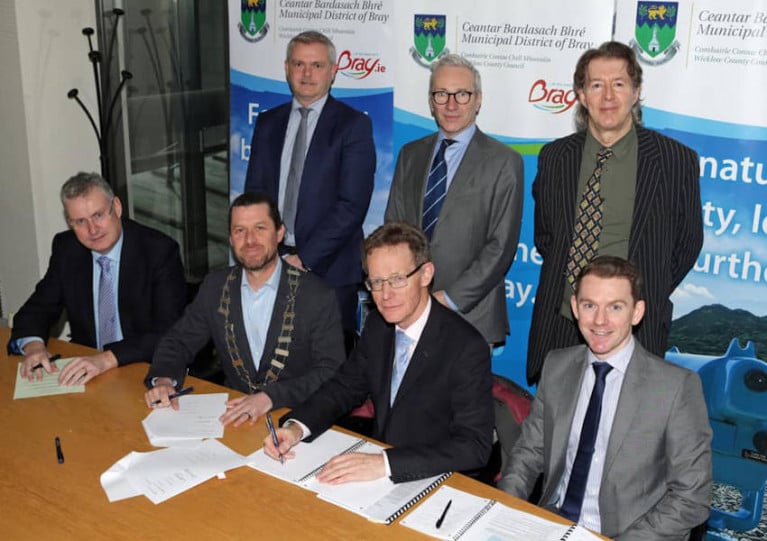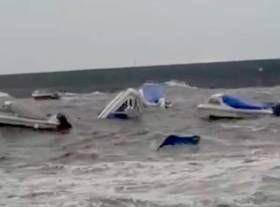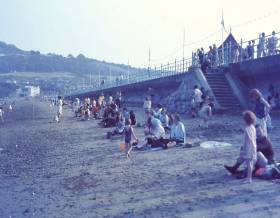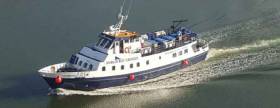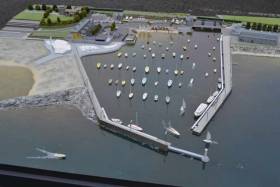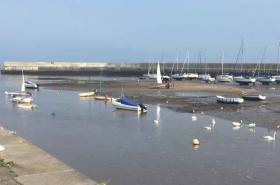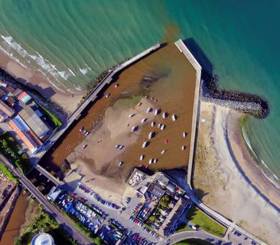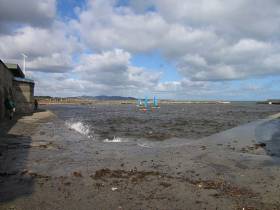Displaying items by tag: Bray Harbour
New Steering Group for Bray Harbour Improvement Scheme
A new steering group has been established to work with consultants, councillors and stakeholders to progress the Bray Harbour improvement project.
As reported last month on Afloat.ie, more than €7.1 million from the Urban Regeneration and Development Fund has been awarded to the Co Wicklow town for harbour rejuvenation works.
On the water, works will include dredging of the harbour allowing for the mooring of larger vessels, with a review of potential for extending the harbour wall to give better protection from waves in stormy conditions.
On land, there are plans for improving street lighting and paving, better provision for motorists and cyclists alike, improved sporting facilities and a new promenade boardwalk linking Bray's renowned promenade with the harbour. It's also proposed to relocate boat storage to the north of the harbour.
Wicklow County Council says it will keep all stakeholders up to date with any new information on its plans for the harbour.
Bray Harbour Gets €7m Funding for Rejuvenation Works
Bray can once again become a proud harbour town with the €7.1m of Urban Regional Development Funding for the rejuvenation of Bray Harbour and the surrounding area. of Urban Regional Development Funding for the rejuvenation of Bray Harbour and the surrounding area.
The proposed facilities for ferry docking and the river deepening will open up tourism and marine leisure commercial activities.
Bray Harbour's Joint Development Committee has welcomed today's announcement by Ministers Darragh O'Brien and Stephen Donnelly.
Welcoming the announcement, committee chairman J J O'Dwyer said: "This funding will benefit not only harbour users, but it will provide significantly enhanced amenities to all the people of Bray".
This project focuses on the regeneration of the Bray Harbour Area and releasing various sites for future development through a series of integrated elements.
The overall vision is to re-imagine and regenerate the strategically located waterfront area of Bray; to increase economic activity, amenity, and connectivity to public transport, the sea-front and esplanade. The aim is to deliver a vibrant public amenity that will be of great benefit to residents and visitors alike. Works envisaged include:
- Amenity and Public Realm – an extension of amenity areas, improvement of the streetscape, parking, cycle provision and sporting facilities
- Promenade Board Walk - linking the promenade with the harbour
- Cycle Bridge - to relieve a pinch point at the Dargle Bridge crossing
- Relocation of boat storage to the north of the harbour
Contract Signed For Bray Harbour Rejuvenation Study
Wicklow County Council last week (Wednesday 29 January) signed a contract for a study of Bray Harbour with consultants RPS Group.
The project requires the consultants to carry out detailed surveys, and report on the options available to protect the harbour from storm conditions.
They are also charged with looking into options to provide additional berthing facilities, including the possibility of providing a short-term drop on/drop off berth for a small passenger vessel plying between different harbours within an hour or so of Bray.
The funding for this exploratory work was approved by members of Bray Municipal District Council in 2018. That plan involves restoration of the south harbour wall to its pre-1957 state, before the collapse of the pier end and lighthouse, as well as providing a deep water channel.
Bray MD Cathaoirleach Steven Matthews said: “I am delighted that we have now engaged RPS Group to develop detailed plans for our harbour.
“Bray Harbour is an amenity that most seaside towns would be extremely envious of and is in urgent need of improvement and development so that we can maximise the potential of this resource for everyone in our community.
“I would like to thank the council officials who have worked so hard to get this far and look forward to seeing this project move on to the next stage.”
Boats Wrecked in Bray Harbour, County Wicklow (Video)
The northerly gales that brought damage to east coast harbours yesterday including Dun Laoghaire on Dublin Bay, also caused damage in County Wicklow at Bray Harbour.
According to local reports, up to eight boats were wrecked in the high seas yesterday afternoon as this reader video (below) illustrates.
There are now 'serious concerns' that more bad weather is on the way this week as Hurricane Lorenzo could hit Ireland on Thursday.
All local authorities have been instructed to activate crisis management.
The Maritime History of Bray Talk Traces Town's Five Harbours
An illustrated talk on the Maritime History of Bray in County Wicklow will take place in the Royal Hotel Bray on Thursday 21/02/2019 at 8pm by Brian White historian/author.
The talk will trace the history of the five harbours of Bray. Stories of smugglers and development of the esplanade and the grand marine promenade and the three Martello Towers.
How a church spire in the town played an important role in calculating pilotage fees for Dublin Port.
The role of the Coastguard Station in Bray and various maritime clubs and societies including Bray Sailing Club, Bray Rowing Club, Bray Swimming Club, Fishermen and Anglers of Bray and Sea Scouting.
In 1957 the lighthouse at Bray Harbour was washed into the sea, prompting the saying “ Bray was the only place in the world with a lighthouse for submarines”.
Bray Harbour Prepares for First Ever Passenger Ship Visit
On Friday 6th July at 7 pm some local maritime history will be made in Bray Harbour when the St. Bridget will make its inaugural visit to Bray with 100 passengers on board. The St. Bridget will dock at the South pier inside Bray Harbour.
Announcing the arrival of St. Bridget in Bray, Wicklow County Council Cathaoirleach Pat Vance said “This underscores the importance and potential of the harbour for Bray. It also affirms the decision of Bray Municipal District to provide funding for the rejuvenation of Bray Harbour on foot of a proposal made by The Bray Harbour Joint Development Committee.
The project involves providing protection of the harbour from the East/Northeast by restoring the south harbour wall to approximately where it was before the collapse of the pier end and Lighthouse in 1957. This will enable the development of facilities that will make the visit of similar vessels a regular occurrence”.
The St. Bridget is known to many for her well-known and highly regarded cruises in Dublin Bay. She is one of five passenger ships owned and operated by Eugene Garrihy, who said “we are delighted to be the first to bring a passenger ship to Bray and hope that this may prove to be the first of many such visits”.
Bray Harbour €1m Rejuvenation Plan Agreed
Bray Municipal District has agreed a plan and to provide funding for the rejuvenation of Bray Harbour on foot of a proposal made by The Bray Harbour Joint Development Committee.
The proposal involves providing protection of the harbour from East/Northeast by restoring the south harbour wall to approximately where it was before the collapse of the pier end and Lighthouse in 1957, training and deepening the river to provide a deep water channel navigable at all stages of the tide and restoring the overall depth of the harbour to 3 hours either side of HW
This will enable the provision of a deep water berth for visiting coastal cruise ships carrying up to 200 passengers, deep water pontoons in the river channel for local harbour users, visitors and marine leisure commercial providers. It will also provide for an increased number of safe revenue generating moorings.
The provision of pontoons will mean that local people and visitors wishing to take to the water will now have easy inexpensive access to marine leisure activities at all stages of the tide.
This development , especially the pontoons, will give impetus to significant opportunities in the growing marine leisure commercial activity generating both increased spend and job numbers in the local economy.
For existing harbour users it will mean safe moorings navigable for longer and the possibility of being able to use boats all year.
There are very significant economic benefits to the local economy in terms of visitor spend, direct earnings from visitor mooring fees and increase in number of moorings available for letting.
The proposal also envisages the creation of an urban space in the southwestern corner of the harbour. This has the benefit of not only creating additional amenity for local people and visitors but also provides a cost effective environmentally friendly means of dealing with the surplus sand to be removed from the harbour floor.
The Bray Harbour Joint Development Committee is made up of members of the Bray Harbour Action Group (representing harbour users) and four representatives from Wicklow County Council.
The likely cost of the project is estimated at circa €1million
This development will not only transform the harbour area but it also has the potential to make Bray an attractive Harbour Town providing additional amenities for local people and attracting visitors by land and sea.
Bray Harbour Action Group Welcomes Council Plan To Deal With Silt–Up
Bray Harbour Action Group (BHAG), at its meeting on Tuesday 21st Feb, welcomed the report by District Manager Des O Brien to the Bray Municipal District meeting on 7th February as reported in the Bray People of 18th February here.
As Afloat.ie reported previously the action group was set up last November to deal with a situation in the east coast harbour that feared would leave a 'real prospect of the harbour becoming an abandoned eyesore'.
“This is a welcome development, said Ger Crowley BHAG chairman, it indicates a commitment by the Council to remedy this threat to the ongoing viability of the harbour. It is reassuring to hear that the sand in the harbour is not contaminated. The favoured approach, therefore, of using it for beach nourishment looks like a win-win solution benefiting both the harbour and the beach”.
“However, he continued, we are deeply concerned re the possibility of delay as the build-up of sand is a ticking time-bomb which if not addressed could well leave the harbour as a permanent derelict eyesore”
Ger went on to say that “the amount of public goodwill towards improving the harbour is terrific and we have been really delighted by the positive public response to BHAG.
Ger also said that “BHAG are really looking forward to taking up the invitation to meet with Bray Municipal Council on April 4th. At the meeting we plan not only to set out our concerns re the harbour but also our vision for a harbour that will benefit all the people of Bray”
Bray Harbour Action Group Formed Over Silt–Up
Clubs and users of Bray Harbour met again last Tuesday night at Bray Head Fishing and Social Club to form the Bray Harbour Action Group to deal with the build up of sand silting up the harbour.
Newly appointed chair of the Bray Harbour Action Group Ger Crowley said “We are at a cross-roads, failure to address the issues affecting the harbour now and in particular the build-up of sand and silt will lead to the real prospect of the harbour becoming an abandoned eyesore. On the other hand if we act now and look to the future we can look forward to a harbour that is a vibrant centre for water based leisure and commercial activity and a magnificent amenity for the people of Bray and beyond.”
Ger continued “We want to work in cooperation and in unison with all stakeholders to achieve a better outcome for all. We have a big programme of work to undertake and we are getting started immediately. We will shortly be seeking a meeting with Public Representatives and Council Officials to outline our serious concerns and explain our objectives”.
Ger is a well- known Bray man, a long time daily user of the harbour in his skiff, round Ireland rower and community activist.
Bray Harbour Action Group has adopted the following objectives:
1. To seek to address the issues, including the build –up of sand and silt, that are causing a real and immediate threat to the future viability of Bray harbour as a centre for water-based leisure and commercial activity.
2. To pursue the achievement of the potential of Bray Harbour as a location of choice for water –based leisure and commercial activity and as a magnificent amenity for all the people of Bray and beyond
Bray Harbour Action Group plans to pursue these objectives by
• Building public awareness re the threats to the harbour and also its potential
• Lobbying for action and support
• Developing and promoting proposals for addressing the threats and for achieving the harbour’s true potential
• Working in cooperation and in unison with other stakeholders
Vigilance After Bray Harbour Engine Thefts
#BrayHarbour - Boat owners in Bray are urged to be vigilant after a number of engines were stolen from boats in the harbour last month.
The Wicklow Times reports that a number of boats moored in the harbour were apparently targeted by thieves who struck in the early hours of Monday 22 August.
A number of engines were taken in the brazen raid, as well as radio and GPS equipment.
"We know it happened at low tide when they would have had easy access," said Bray Sailing Club Commodore Mark Henderson.
"Unfortunately all our CCTV could pick up was flashlights as we know the robberies took place between 2 and 3am ... but it was too dark to make out faces."
Anyone in the market for a secondhand engine has been asked to check where it came from, and report any suspicions to the relevant authorities.


























